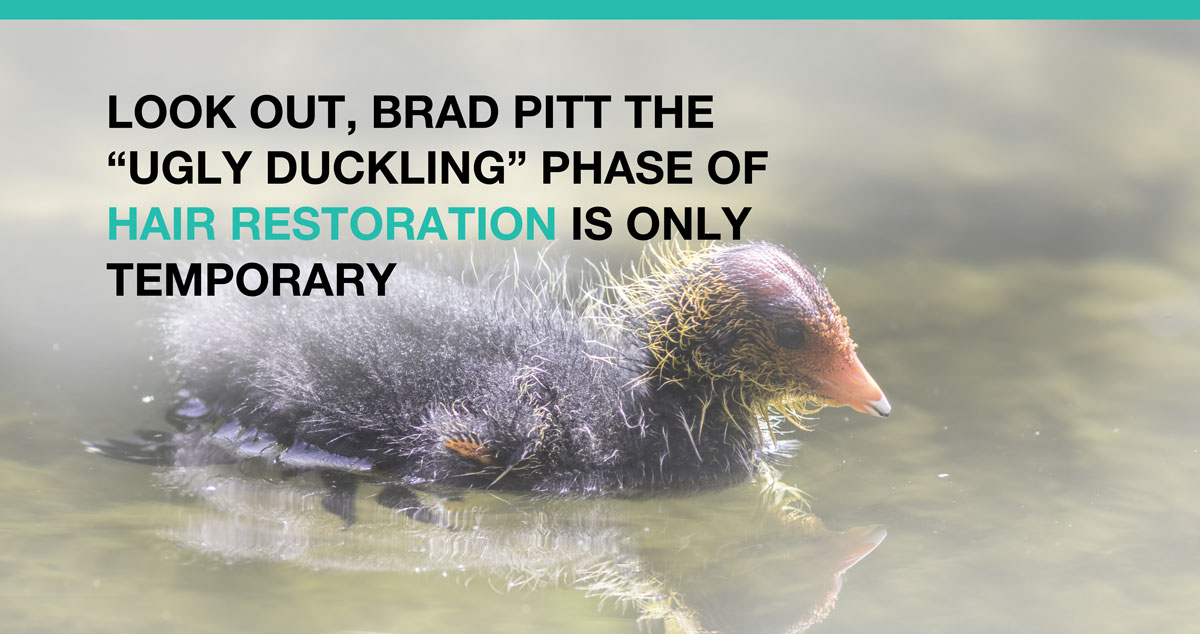
For some men, making the decision can take months. For others, it can take years. But once they decide to undergo a hair restoration procedure, their days of frustration and embarrassment over thinning and lost hair are numbered. If it’s possible to get a fresh start in life, this is it.
You may be able to identify with this giddy feeling of anticipation, even if you didn’t tape inspirational head shots of George Clooney and Brad Pitt to your bathroom mirror. So it’s no wonder why you may feel a bit deflated upon learning about the “ugly duckling” phase of hair restoration surgery.
As with all matters dealing with hair restoration, you’re smart to seek out answers to your questions before your procedure. And in this case, you’ll be especially glad you did because while you may not end up looking like Brad Pitt, this phase is like many others in life: far from a certainty but definitely short-lived.
The “duckling” isn’t ugly for long
The so-called ugly duckling phase shouldn’t stir fear and trepidation. It may even sound worse than it is: an area of redness or pimples in what is called the “recipient area” of a hair transplant. Some women who dye their hair at home with a store-bought hair dye experience a similar consequence, so you may recognize the similarity.
Whereas the chemicals in hair dye can cause a temporary redness around the scalp, the ugly duckling phase is triggered by the actual hair restoration procedure and, specifically, when new hair begins to grow about three or four months after the procedure. This growth can irritate ingrown hairs and/or trigger pimples or redness. Just how red varies from one person to another, but the shade can range from slightly red to bright red. Some people consider the transformation less “ugly” than annoying. But this change in appearance, combined with the possibility of the recipient’s real hair appearing thinner than it was before, is why the process is called the ugly duckling phase of hair transplant procedures.
It’s important to remember that not every hair transplant recipient goes through an ugly duckling phase. It’s not a foregone conclusion; some people never experience it. But if it does occur, it may help to know that it’s perfectly normal. It also begins to subside after new hair begins to grow in earnest.
As you may know, most people experience substantial hair growth six to eight months after a hair restoration procedure. At this point, the ugly duckling phase is much like that initial period of curiosity, investigation and follow-through. It’s temporary. And it’s in the past.
Dr. Williams inspires confidence
A concealer or medication can help mitigate the ugly duckling phase, which is another reason why you want only the best hair restoration surgeon at your side: to give you the best advice. This is why so many people rely on Dr. Joseph L. Williams of the Advanced Medical Hair Institute.
He knows that everybody responds somewhat differently to hair restoration. And he reminds his patients that the procedure is a process—one that involves healing, growth and hair maturation that is unique to the individual. He can’t guarantee a head of hair that would inspire envy in George Clooney or Brad Pitt. But he can help you navigate every step of the process with confidence, which is a fine precursor to the confidence you’ll feel with a fully restored head of hair.










